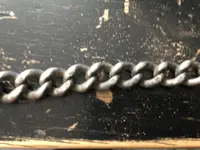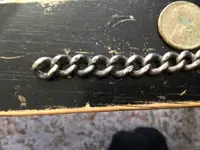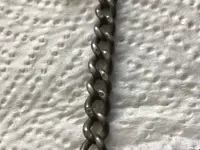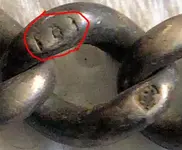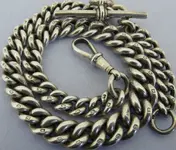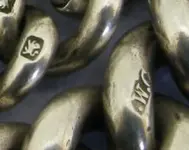Hi Joe
A said, the lion is the general sterling mark and not specific to Birmingham.
Under our hallmarking regulations, something comprised of multiple parts which are all to the same standard of silver is regarded as a single ‘article’ if the components are essentially ‘inseparable’… as would be the case for soldered links on a chain.
The article itself then needs to carry the compulsory marks for fineness, assay office, date letter, sponsor (usually the maker, but not always), and duty mark (as the monarch’s head, but only between 1784 and 1890). However, these marks do not all need to present on each individual inseparable part nor together on one part… they can be spread across several parts, particularly if the available readily visible surfaces are small. The application of a sterling mark on each and every link was common practice in the 1800s as a matter of prestige and customer reassurance rather than a legal requirement and continued well in to the 1920s at least, before gradually falling out of favour.
On your chain, I believe I can see a sponsor mark on one of the links (ringed in red, below):
View attachment 2052948
It’s not very clear, but
might be ‘W.B’ with a stop between the letters, which
could be for William Bateman of London and from between 1814-1839. If that is his mark then there should also be duty mark on one of the links (as the head of George III, George IV, William IV or Victoria) as well as a date letter. However, to me, the chain style looks to be later Victorian or first half of the 1900s and I’m guessing it’s a watch chain(?). if it’s post 1890, there will be no duty mark (and it’s not then from Bateman).
One other thing to note is that in the 1800s and through to the first part of the 1900s a number of manufacturers operated exclusively as ‘chain makers’ but didn’t produce anything else. The chains were then assembled into finished articles by jewellers who might have different sources for their components or be self-making them. So, something like a watch chain might have one set of marks on the chain itself and other marks on the swivel (dog-clip) and/or the T-bar. This one, for example was said by the seller to be Birmingham sterling hallmarked for 1899 (Anchor and date letter ‘Z’) with a sponsor mark of ‘HP’ on the swivel and T-bar. The smaller surfaces of the chain itself only carry the sterling mark on each link but with one of the links obviously carrying the mark for a different maker/sponsor:
View attachment 2052958 View attachment 2052960



